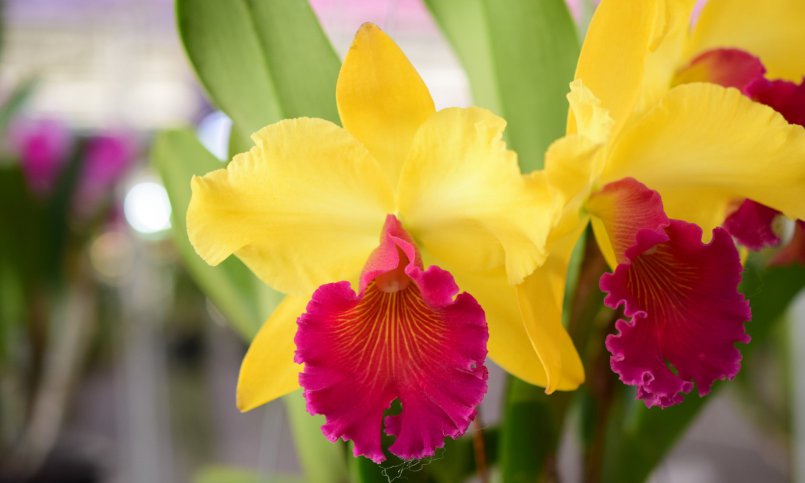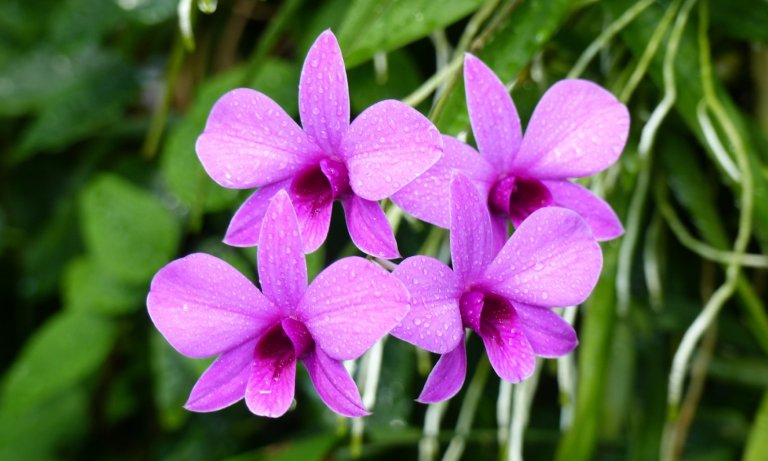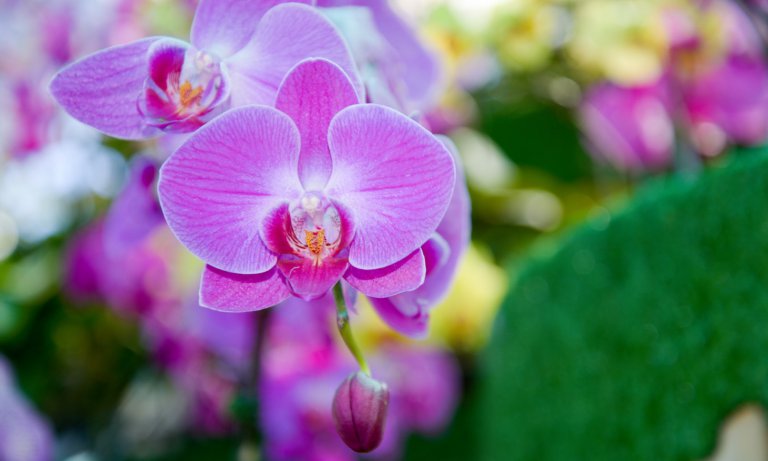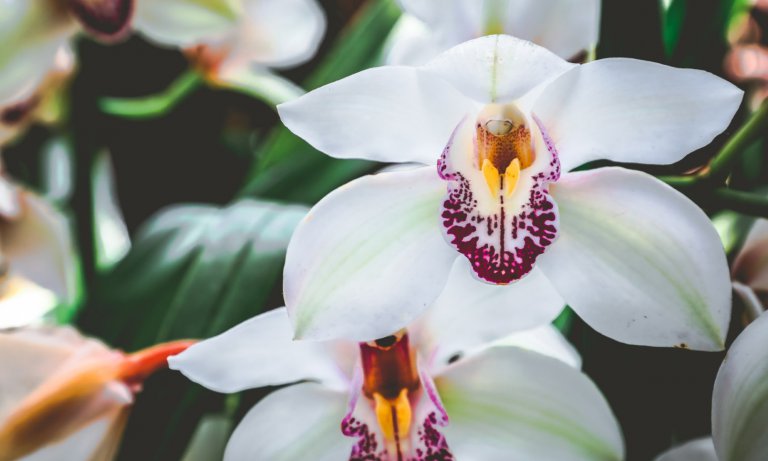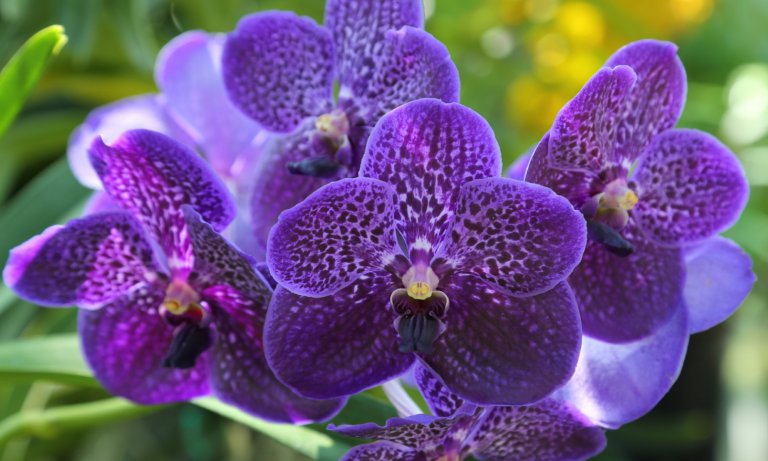Cattleya, the “Queen of Orchids,” is a popular variety for both novice and experienced growers. She has a lovely fragrance, expansive blooms, and striking colors.
Fortunately for the beginner, Cattleya orchids are also forgiving plants to grow in the home. They tolerate a wide range of conditions and their pseudobulbs make it easy to tell when they need watering.
Let’s start by taking a look at the natural habitat of the Cattleya orchid, so we can understand how to care for one.
Natural Habitat
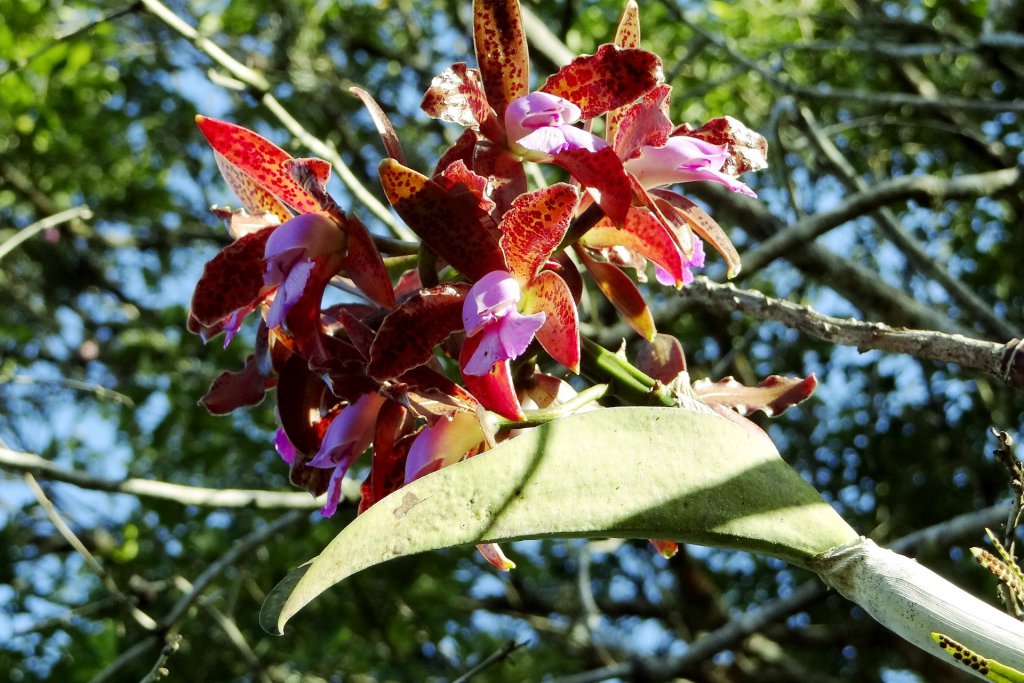
This variety evolved in the rainforests of South America, growing along the trunks and branches of host trees in the humid canopy.
These non-parasitic plants do not draw nutrients from the trees, however. Instead, their specially evolved roots absorb moisture and nutrients from the air and debris caught around the base of the plant.
While they are tropical, most species of Cattleya live at higher elevations. They benefit from lower temperatures in the morning and evening.
How to Care for a Cattleya Orchid
Imagine this natural environment when you pot, place, and water your orchid. It will guide you toward keeping it healthy.
We can break this down into a few different aspects:
Light
In their jungle home, sunlight is abundant but also filtered through the growth above and around them. Too much full, direct sunlight will dry out and burn the plant. Too little will stunt growth and prevent flowering.
When you choose a place for your plant, ensure that there will be plenty of indirect light, especially early in the day. If it’s near a window that gets a lot of direct sun, shield your orchid with a sheer curtain.
Depending on where you live, it will be necessary to move the orchid into more sunlight during the winter months when days are shorter and increase shade in the summer.

Balance is essential. If you notice that your Cattleyas drying out quickly or showing signs of sunburn, make sure to protect it from too much direct light.
Temperature
The ideal temperature range for these plants is between 70 and 80°F during the day, with a drop to the low 60s at night. Cool nights help to prompt blooms and steady growth.
If you live in a climate with warm summers and cold winters, place these orchids outside in areas of indirect lighting from late spring until the first frost.
During winter, be sure to keep your orchid away from heaters because the dry air will wither and damage it. Temperature shock can also adversely affect the health of the plant, so it’s best to keep it in an area with gentle air circulation and no strong drafts.
Humidity
Cattleya orchids are tropical but do not need to be grown in a sauna. They like humidity ranging between 40 and 70%.
There are a handful of simple ways to raise the humidity levels in the area where your plant is growing.
For single plants or small groups, place a tray of water and pebbles or gravel near or beneath the plants. If the plants are on the tray, make sure there’s space between the bottom of the pot and the water. Otherwise, the pot won’t drain properly, and the roots will rot.
If you live somewhere very humid, air circulation will be vital for your orchid. Stagnant moist air creates an environment for rot and diseases to take hold.
Watering
The Cattleya is a “sympodial” orchid, meaning it grows from a horizontal stem or “rhizome.” The rhizome sends out creeping roots, and thick pseudobulbs grow upwards. The flower stalks emerge from these.
Pseudobulbs store water to carry the plant through the dry season. This allows these orchids to go longer between waterings than their single-stemmed “monopodial” cousins.
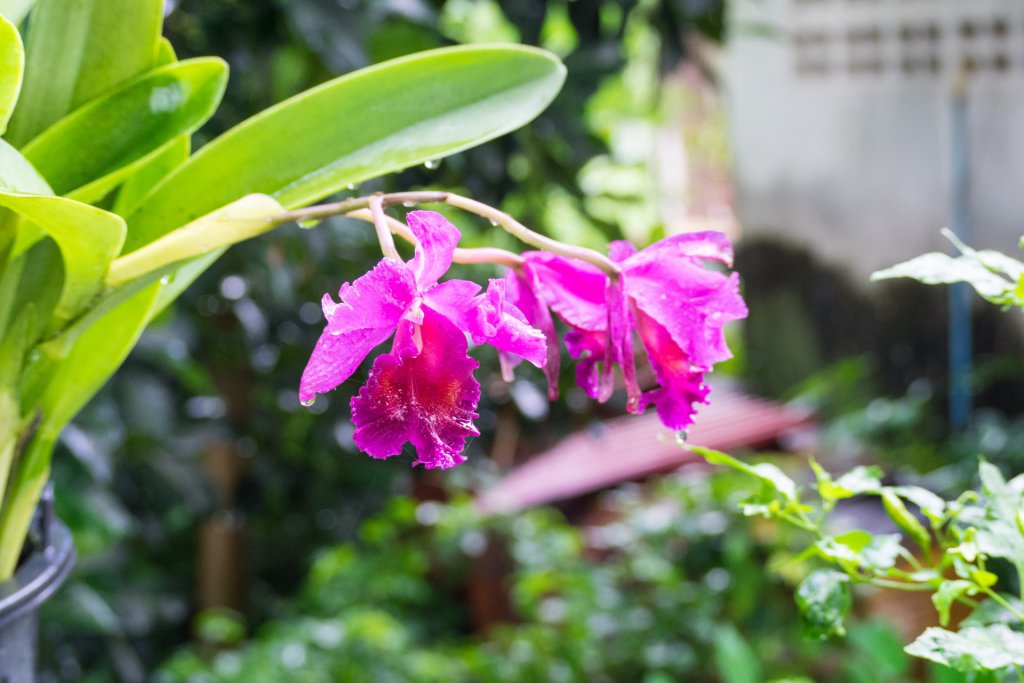
During hot, dry weather or sunny afternoons, gently mist the plant to help keep it moist. If the pseudobulbs are starting to wrinkle, it’s a sign that your orchid needs more water.
You can also consider placing your orchid in a humid bathroom or kitchen if there is enough light.
Potting Mix & Pot
Cattleyas should not be grown in regular potting soil. Instead, choose a looser medium.
Chopped fir bark is very popular, though growers in particularly humid areas may choose an even drier medium like coconut husk or even gravel. The growth medium needs to drain well to avoid root rot.
Over time, the bark, moss, or fiber that your orchid is planted in will break down and compact. If the growth medium has broken down to the point where it starts draining poorly, it’s time to repot the plant in fresh material.
Choose a pot that drains well, so the roots don’t rot. Cattleyas like a smallish pot, that doesn’t leave too much space.
Repotting
In general, expect to repot these orchids about every two years. You’ll know it’s ready for a new pot when the rhizome reaches the pot edge and starts trying to send growth out over the side.

Keep in mind that the plant likes a snug fit in its pot and don’t place it in a pot that’s too large. It should not have more than two years’ worth of room to grow at any given time.
To repot, carefully remove the orchid from its old pot and remove as much growth medium as you can from the root system. Only trim away soft, brown roots that are showing signs of rot. Never trim back aerial roots emerging from the rhizome, even if they overhang the edges of the pot.
The rhizome grows in one direction, and new pseudobulbs emerge from the growing end. When you repot the plant, place the oldest growth closest to the edge of the pot and the growing end of the rhizome toward the center.
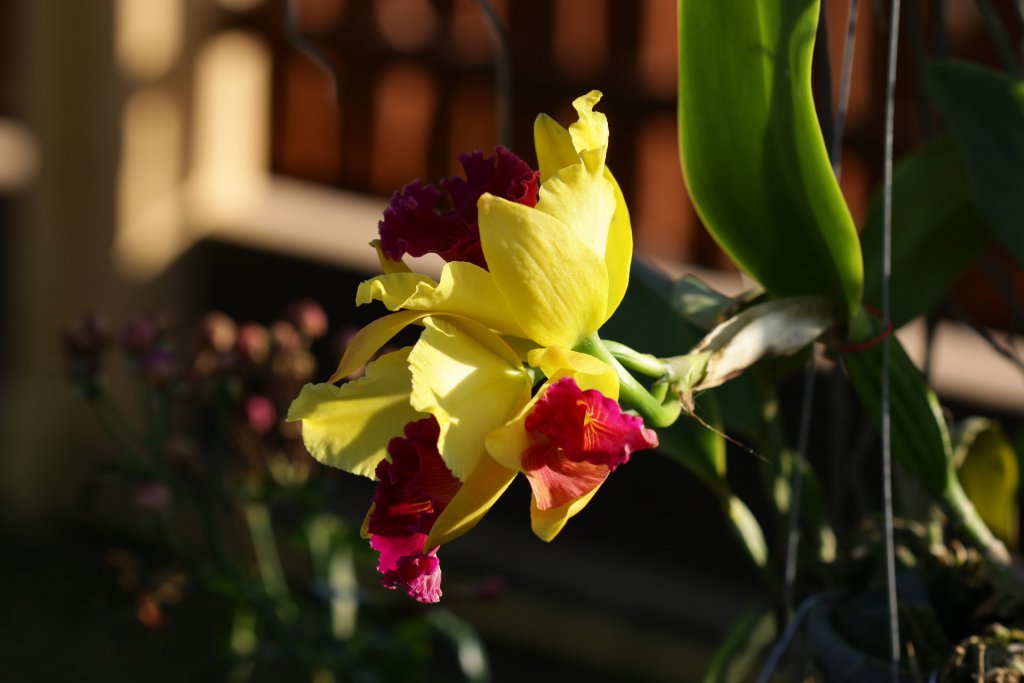
Gently tuck growth medium around and into the roots until the pot is full, and the orchid has firm support. You may want to stake or clip the orchid in place as it gets established.
Your orchid should not be repotted while in bloom.
For more information, check out our step-by-step repotting guide.
Fertilizer
These orchids do not need heavy fertilization, and over-feeding them can damage the roots and kill the plant. They will grow and bloom more vigorously with an appropriate amount of nutrition.
Fertilize your orchid at a low strength during active growth around every other time you water. In winter, when the plant is dormant, fertilization can be discontinued or reduced to once a month.
If you’re uncertain whether or not your plant should be fertilized, do without.
Blooms

Some individual species will flower once a year, and others can bloom multiple times. In general, a Cattleya will need the most water and nutrients when actively growing and blooming.
They will then enter a rest period where moisture and fertilizer should be restricted. If your orchid is putting up new growth and flowering regularly, then watering and feeding should be more consistent.
Care Summary
Here’s a recap of what we just learned:
| Light | Lots of indirect light |
| Temperature | 70F to 80F (day), 60F (night) |
| Humidity | 40 to 70 percent |
| Watering | Mist, when pseudobulbs are starting to wrinkle |
| Potting Mix | Chopped fir bark |
| Pot | Snug fit, good drainage |
| Repotting | Every two years, not during blooming |
| Blooms | Once or multiple times a year, depending on species |
| Fertilizer | Sparingly, every watering during active growth |
If you’d like to download this as a handy cheat sheet, right-click the image below and select “Save Image”:
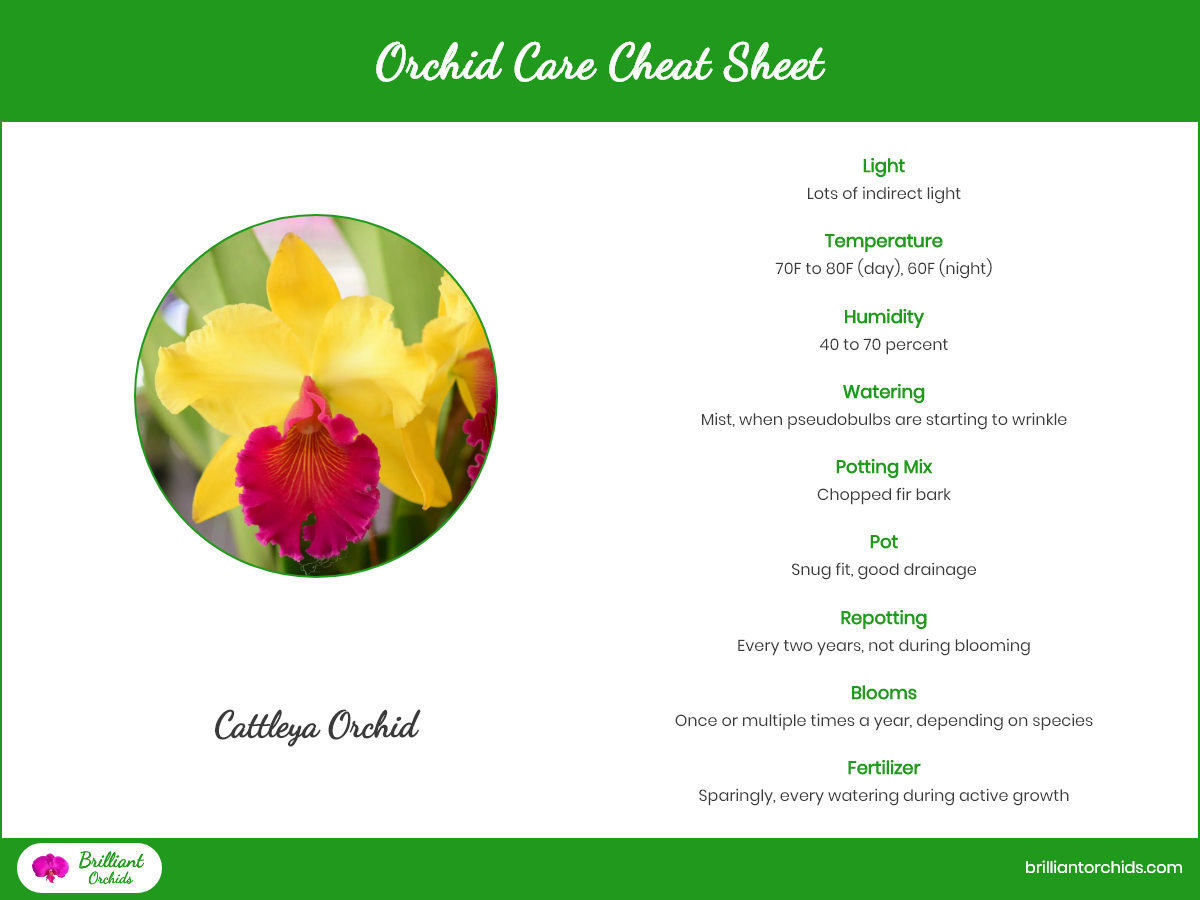
We recommend printing it off and keeping it by your orchid. Please share it if you find it useful!
Frequently Asked Questions
Here are some common questions about Cattleyas:
Are Cattleya Orchids Hard to Grow?
Cattleyas are relatively easy to grow. They’re actually one of the better orchids for beginners.
In particular, the pseudobulbs take a lot of the guesswork out of watering. They also mean it’s not the end of the world if you forget to water your plant for a few days.
Aside from that, make sure your orchid has a bit of shade, so it doesn’t get sunburnt. Follow the care summary above, and you’ll be just fine.
Should I Worry About Pests and Diseases?
Always keep an eye out for pests and infections.
Mealybugs and scale can quickly kill your orchid but can be controlled with diligent but gentle applications of rubbing alcohol. Use a cotton swab or pad to remove the pests. Isolate the infested plant and re-treat it weekly for up to a month.
Bacterial and fungal infections can move quickly, and you need to address them before they overwhelm the plant. If soft brown or black spots are developing on the leaves or flowers, cut away the afflicted growth with clean shears.
Thanks for reading, we hope you found this guide useful. What are your favorite tips and techniques for growing Cattleyas? Let us know in the comments below!

